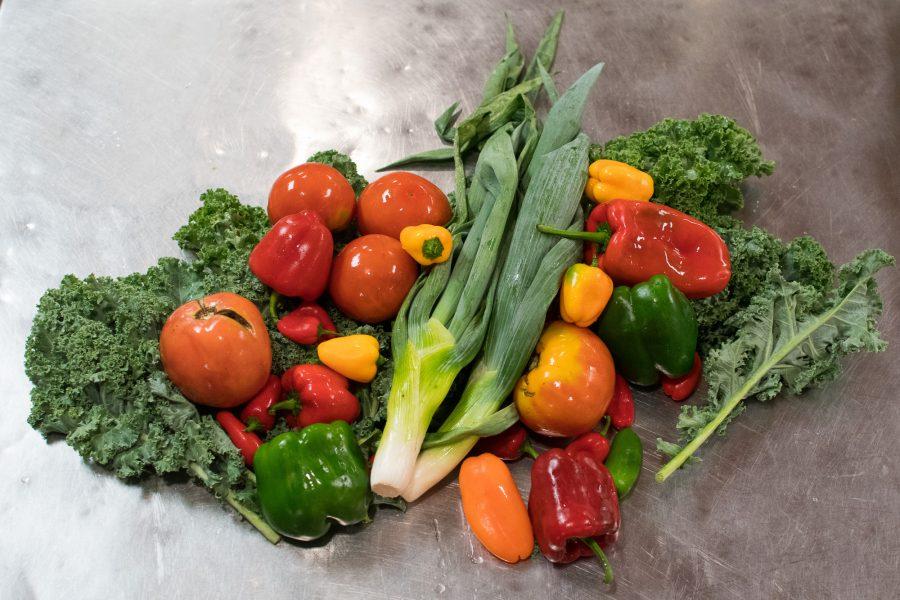Local, sustainable food a focus for campus dining
Some of the fresh vegetables that the Newman Cafeteria uses to create healthy meals for students sit on the table on Wednesday, September 14, 2016.
Sep 14, 2016
Tomatoes, kale, beets, spinach, banana peppers — a plethora of produce and meats are bought locally, cooked by Hendrick House employees and served to the students.
Stickers above the food in Newman Hall signal if it’s local.
“Anywhere you see ‘locally sourced’ stickers, that’s either from our farm or other meat farm or poultry farms,” Newman Hall Head Chef Ryan Pecchenino said. “These stickers are kinda of all over the place.”
Newman Hall began bringing locally grown and sourced food when Hendrick House came in three years ago. It has 35 accounts on campus, a majority of them being at fraternities or sororities. But they also provide meals at Newman Hall, Presby Hall and Armory House.
All locations serve locally grown food, said Hendrick House Interim Food Service Director Diane McNattin.
Get The Daily Illini in your inbox!
“It all started in 2009; we put a green roof at Hendrick House. In 2010, we decided to utilize that space to grow herbs. We put in ground planters, planting boxes, and filled it with ewe-poo [compost], and to grow herbs in, and some small plants. The following year, we went to Meadowbrook Gardens, and we started a plot there that turned into two plots,” McNattin said.
Through creating relationships with farmers and suppliers, Hendrick House has been able to be involved with many local farmers’ small businesses.
It buys all of its eggs from Cascade Poultry in Fairbury, IL. The farmer, JoEllen Gehring, initially did not have enough eggs for the multiple halls and many houses Hendrick House serves.
However, she committed to adding more produce to fit their needs.
“Every year it’s more and more, and she’s been able to add a barn to her farm. And her children now work there through her,” McNattin said. “It’s good to know that we are changing people’s lives and giving them business.”
With donuts from Ye Old Donut Shop and coffee or tea from Columbia Street Roastery, both McNattin and Pecchenino emphasize the importance of supporting the local community.
“You just feel good when you’re cooking with their food or supporting a small family like JoEllen’s,” Pecchenino said. “If I could have everything be local, that would be ideal.”
In Newman Hall alone, Pecchenino said about $3,000 to $5,000 a week is spent buying local food. Over the course of a year, Ikenberry Dining Hall serves about $1.8 million of local food, with $4 million spent overall on campus dining halls, said Aubrey Dawn, associate director of housing for dining services.
Dawn says currently 28 percent of the food budget is designated for produced or processed food. With iCAP, the 2020 sustainability path for the campus, Dawn says they want to hit 40 percent.
Processed food refers to locally produced food, prepared and then given to the University, Dawn said. For instance, the soft-serve mix is the same mixture used at the local Dairy Queens.
The division between organic versus local food is one that both Dawn and Hendrick house recognize, but is also where they are different. The goal of most University housing is local and sustainable, Dawn said.
“Even though it is organic doesn’t mean it’s sustainable or local. We look at all of the choices to procure, that it is local, that it is sustainable,” Dawn said. “If it is an animal protein, we want to make sure that it is treated well, that it is harvested correctly. We actually tour these facilities — we take this very seriously.”
However, McNattin said they try to grow as organic as possible, which they do on their two-acre plots on the corner of Lincoln and Windsor.
“All of our plants, all of our food, is grown organically as much as possible. We learned the hard way that completely going organic is [difficult]. We try to grow as organic as possible,” McNattin said.
Certified organic foods must go through a process with the USDA, McNattin said.
“We choose not to go through that certification process, but we stand behind our product in that we try to be organic as possible. But our main goal is to source as much locally as we can,” McNattin said.






